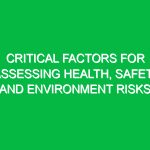Introduction
In the realm of Health, Safety, and Environment (HSE), understanding and addressing trip Hazards is paramount. Trip Hazards refer to any objects or conditions that can cause a person to trip, stumble, or fall, leading to potential injuries. These hazards are not just minor inconveniences; they pose significant risks in workplaces, where they can affect employee well-being and organizational productivity.
Every year, thousands of workplace injuries occur due to slips, trips, and falls, making it crucial to identify and mitigate these hazards. Addressing trip hazards is not merely about compliance; it’s about creating a safer environment that fosters productivity and employee morale. In this article, we will delve into the various aspects of trip hazards, explore real-life examples, discuss the importance of Regulations, and provide actionable insights for enhancing Workplace Safety.
Understanding Trip Hazards in the HSE Context
Trip hazards can manifest in numerous forms, and their identification is the first step toward creating a safer workplace. Common examples include:
- Uneven flooring or surfaces
- Obstructed walkways
- Worn-out carpets or mats
- Open drawers or cabinets
- Cables and cords running across walkways
- Wet surfaces from spills
Recognizing these hazards requires a keen eye and a proactive approach. Each workplace has its unique layout and activities, which means that the types and locations of trip hazards can vary significantly. For instance, a manufacturing plant may have different hazards compared to an office environment.
In an office context, cluttered desks and obstructed aisles can lead to falls. In contrast, a construction site may have uneven ground and materials scattered about. It is vital for employers to conduct regular assessments of their workplaces to identify these hazards and implement appropriate measures to mitigate them.
The Importance of Identifying and Mitigating Trip Hazards
The significance of addressing trip hazards cannot be overstated. Falls are among the leading causes of workplace injuries, which can result in lost workdays, increased insurance premiums, and potential legal liabilities.
Take, for example, the case of a warehouse employee who tripped over a pallet left carelessly in the aisle. The resulting injury not only affected the employee’s ability to work but also led to an investigation that revealed a pattern of neglect regarding workplace organization. This incident served as a wake-up call for the management, prompting them to implement stricter protocols for maintaining clear walkways.
By proactively identifying and mitigating trip hazards, organizations can:
- Enhance employee Safety and morale
- Reduce the frequency and severity of workplace injuries
- Lower insurance and liability costs
- Improve overall workplace productivity
Best Practices for Managing Trip Hazards
To effectively manage trip hazards in the workplace, organizations should adopt a multifaceted approach. Here are some Best Practices:
1. Conduct Regular Safety Audits
Regular safety audits help in identifying potential trip hazards. These audits should involve a thorough inspection of the workplace, focusing on high-traffic areas and locations where employees frequently move. Involving employees in these audits can also provide valuable insights, as they are often aware of hazards that management may overlook.
2. Implement Clear Housekeeping Protocols
Maintaining a clean and organized workspace is crucial in minimizing trip hazards. Clear protocols should be established for housekeeping duties, ensuring that all employees understand their responsibilities regarding clutter management. For instance, ensuring that all materials are stored properly and walkways are kept clear is essential.
3. Provide Training and Awareness Programs
Educating employees about trip hazards and Safe Practices can significantly reduce incidents. Training should cover how to identify potential hazards, the importance of reporting them, and techniques for safe movement within the workplace. For example, training sessions can include practical exercises on how to navigate common hazards safely.
4. Use Signage and Markings
Proper signage can alert employees to potential trip hazards. For instance, using bright tape to mark uneven surfaces or placing warning signs near wet floors can increase awareness and help prevent accidents.
5. Encourage a Culture of Safety
Fostering a culture of safety within the organization can encourage employees to take an active role in identifying and mitigating hazards. When employees feel empowered to voice their concerns about potential hazards, it creates a proactive safety environment.
Real-Life Examples and Case Studies
To illustrate the impact of trip hazards and the effectiveness of mitigation strategies, consider the following case studies.
Case Study 1: The Construction Site Incident
A construction company experienced multiple incidents related to trip hazards over a six-month period. Following a thorough investigation, the management discovered that workers were frequently tripping over tools and materials left in walkways. In response, they implemented a strict policy for tool organization and designated specific areas for material storage. This proactive approach led to a 60% reduction in incidents over the next year.
Case Study 2: The Office Environment
In an office, an employee tripped over a power cord that was running across a high-traffic area. This incident prompted management to evaluate the layout and conduct a safety audit. They introduced cable management solutions and reorganized workspaces to eliminate similar hazards. Employee feedback indicated a heightened sense of safety, and there were no further incidents related to trip hazards in the subsequent year.
Regulations and Standards Governing Trip Hazards
Various regulations and standards govern Workplace Safety, including those related to trip hazards. In the United States, the Occupational Safety and Health Administration (OSHA) plays a crucial role in setting and enforcing safety regulations. osha mandates that employers provide a workplace free from recognized hazards, including those that could lead to trips and falls.
The American National Standards Institute (ANSI) also provides guidelines that businesses can follow to enhance safety. Compliance with these standards not only improves Workplace Safety but also protects organizations from potential legal liabilities.
Conclusion
Trip hazards represent a significant risk in various workplaces, impacting employee safety, productivity, and organizational costs. By understanding the nature of these hazards, implementing Best Practices, and fostering a culture of safety, organizations can significantly reduce the risk of falls and related injuries.
It is essential for every organization to take trip hazards seriously and to view them as a critical component of their overall health and safety strategy. By addressing these hazards proactively, businesses can not only comply with regulations but also create a safer and more productive work environment for everyone involved.
Awareness and action are key. Let us continue to prioritize safety and ensure that our workplaces are free from the risks associated with trip hazards.


